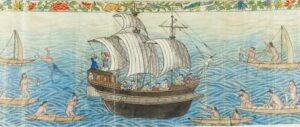The Global Silk Trade
This module examines how and why the first globalization happened in world history starting in the 16th century, using the example of the production and trade of silk across the Pacific Ocean. It focuses primarily on the links between southeast China and New Spain (colonial Mexico) through Manila and traces the production, consumption, and regulation of silk textiles. This teaching module aims to help students learn how and why global interconnectedness emerged by understanding factors shaping the production, transport, and consumption of goods on a global scale, and the interaction of environmental, social, cultural, economic, and political factors on historical developments. It illustrates the emergence of early modern interconnections, demonstrates how Pacific Ocean became the center of new global exchanges, and provides a broader context to understand the ways in which the people of Europe, Asia, and the Americas all integrated into a globalizing world.
Original version authored by Xiaolin Duan
Readings and Primary Sources
Module Lesson Plan:
- Silk-Trade-0.0-Module lesson plan
- Silk-Trade-0.1-Schedule-at-a-glance
- Silk-Trade-0.2-About-this-module-for-students
Lesson 1:
Lesson 2:
- Silk-Trade-2.2-Reading 2-The production of silk
- Silk-Trade-2.3-Primary Source-Pictures of tilling and weaving
- Silk-Trade-2.4-Primary Source-Sierra texupan codex
Lesson 3:
- Silk-Trade-3.1-Reading 3-New silk fashions
- Silk-Trade-3.2-Primary Sources-Silk fashions in China
- Silk-Trade-3.3-Primary Sources-Silk fashions in New Spain
Lesson 4:
- Silk-Trade-4.1-Reading 4-The Manila Galleon Trade
- Silk-Trade-4.2-Primary Sources-The Manila Galleon Trade
Conclusion:

